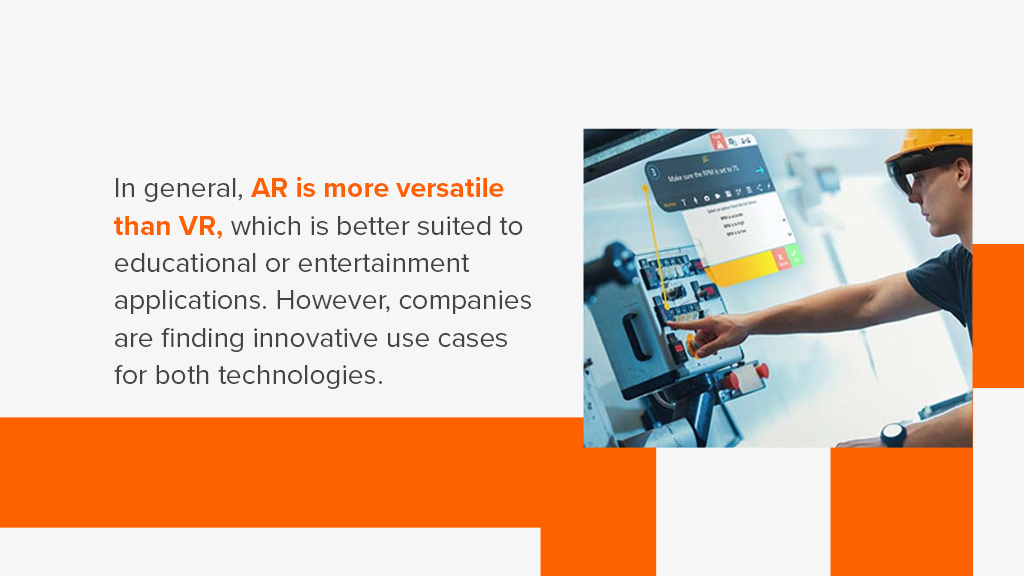Augmented Reality vs. Virtual Reality
Modernization is becoming increasingly important for companies in the 21st century. Extended reality technologies, like augmented reality and virtual reality (AR/VR), are some of the solutions companies are adopting to improve operational processes and reduce costs.
According to the International Data Corporation (IDC), AR/VR spending will grow to $50.9 billion by 2026. At a compound annual growth rate of 32.3%, that’s a dramatic increase for a fairly new technology.
Understanding the difference between augmented reality vs. virtual reality can help you determine whether these technologies are right for your organization.
What Is Augmented Reality and How Does It Work?
As the name implies, augmented reality (AR) is a technology that adds digital elements to the user’s physical environment.
The three defining characteristics of AR include:
- Environment: AR combines the digital and the real world to create an enhanced version of reality.
- Interactivity: Users can interact with virtual elements in real-time.
- Identification: AR software is able to accurately identify 3D objects in both the real and digital worlds.
Technology requirements for AR include a camera-equipped device, such as a mobile phone or tablet, and the appropriate software. Although users do not need external controllers for most commercial AR applications, purpose-built software may require specialized headgear.
Using input from the device’s camera and any connected sensors, AR software reads a user’s physical environment and places an interactive digital overlay on the scene. This overlay includes digital assets such as 3D models, images and videos.
For example, some online clothing companies allow shoppers to virtually try on products using AR technology. And many social media apps, like Snapchat and Instagram, apply AR face filters to users’ pictures to alter their appearances.
Advantages and Disadvantages of Augmented Reality
Here are the main advantages of AR technology:
- Portable: AR only requires a camera-equipped mobile device, like a smartphone or tablet.
- Collaborative: AR software allows users to share and interact with content in real time.
- Versatile: There are applications for AR in almost every industry, from entertainment to construction to health care.
The primary drawback to AR is that there can be a steep learning curve for more advanced software programs. Because AR is still a relatively new technology, few people have extensive experience with it — it can take some time for employees to become comfortable using it.
What Is Virtual Reality and How Does It Work?
Virtual reality (VR) is an immersive reality technology that allows users to enter a completely digital environment independent of their physical location. For example, VR could let you travel to Mars without ever leaving your couch.
This immersion is why VR has become so popular in gaming and entertainment, and it’s also why VR simulations are useful for training purposes. VR systems use advanced computer-generated graphics and computer vision — an AI technology that enables computers to understand visual inputs — to create a realistic, true-to-scale environment.
Users need sensory equipment such as headsets and hand controllers to navigate this environment. These devices are equipped with sensors that track the user’s body and eye movements. The computer responds to input from the sensors by altering the environment in realistic ways — for example, if a user extends their hand toward a digital object and squeezes the controller, they can pick it up.
To create a truly immersive environment, the user must be completely shut off from the physical world — this is why VR headsets block the field of view. The system may also use sensory factors, like smells and sounds, to deepen the immersion.
Advantages and Disadvantages of Virtual Reality
The primary advantage of VR is its ability to create a realistic, immersive experience. Unlike AR, VR technology places users in a pre-programmed digital environment. Everything a VR user interacts with during the session is completely virtual, but it can feel real.
Some of the drawbacks of VR include:
- Hardware limitations: You need a VR headset and hand controllers to enter virtual reality, which can make using it in the field difficult.
- Cybersickness: The disconnect between your movements in the virtual world and the real world can trigger motion sickness, or “cybersickness,” in some users. Symptoms can include nausea, dizziness and blurred vision.
What Are the Differences Between AR and VR?
Both technologies are at opposite ends of the reality spectrum, with AR being closer to complete reality and VR at the completely virtual end. Here’s a quick comparison of AR and VR differences:
- Immersion: VR is a fully immersive experience, while AR is only partially immersive.
- Hardware: Most AR programs only require a camera-equipped mobile device or machine-mounted screen, while VR requires a specialized headset and hand controllers. However, some purpose-built AR systems require additional controllers.
- Senses: In a VR experience, what a user senses is completely under the control of the simulation. However, in an AR experience, the user stays connected to the physical world.
- Purpose: While VR replaces the real world with a digital one, AR enhances the real world with virtual assets.
- Bandwidth: AR requires significantly more processing power than VR.

In general, AR is more versatile than VR, which is better suited to educational or entertainment applications. However, companies are finding innovative use cases for both technologies.
Applications for Augmented Reality
Some common applications for AR technology include:
- Advertising: The advertising industry has been adding AR elements to mobile ads to boost engagement and drive conversions.
- History: AR can bring the past to life by placing fact bubbles, photos and animations into the user’s physical location.
- Field services: Field workers can access digital how-to guides and tutorials on their phones to improve job performance and provide better service.
- Healthcare: Neurosurgeons can use an AR projection of a 3D brain to guide surgeries.
Applications for Virtual Reality
Some common applications for VR technology include:
- Gaming: VR technology creates a dynamic, immersive environment that allows players to interact with characters in their favorite games.
- Employee training: Realistic VR simulations are useful for training employees on complex technologies and safety protocols.
- Psychological treatment: Virtual reality exposure therapy (VRET) is a therapeutic technique for people who suffer from conditions like post-traumatic stress disorder (PTSD) and traumatic brain injuries (TBI).
Enhance Field Work With AR Software From Taqtile
Both AR and VR are revolutionizing the way we do business. From training and job performance to knowledge retention and transfer, AR helps companies transform operations for the 21st century.
Leverage AR technology to improve performance with Manifest® AR software from Taqtile. This program allows deskless workers to document MRO procedures, access step-by-step guides and collaborate remotely with experts.
Contact us today to speak with an AR expert about how Manifest® can benefit your company, or click here to schedule a live demo.




